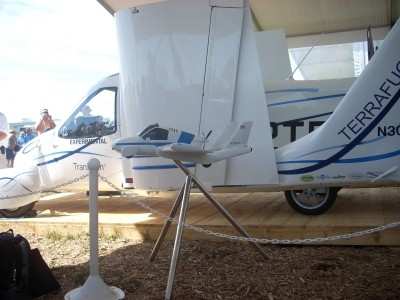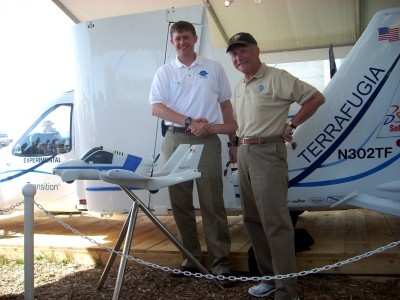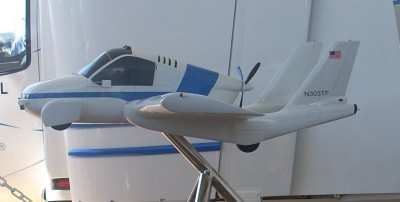Flight Testing And Modeling Basis For Next Prototype Currently
In Production
By Maxine Scheer
Attendees at the opening day of EAA AirVenture Monday were
provided an update on the progress of the Transition Roadable
Aircraft, or "Flying Car" and the unveiling of a scalable model of
the Beta Prototype (stage 2) next generation design. "Terrafugia
has been incubated at EAA", said EAA President Tom Poberezny at
Monday's news conference. Poberezny speculated the first flight of
the next generation Transition would occur at AirVenture in
2011.

Specifications shared today on new design features added to the
Transition include:
- Automotive-style crash safety features, including an energy
absorbing crush structure in the nose of the vehicle and rigid
safety cage.
- A customized, intuitive touch-screen interface to the
cockpit.
- Improved airfoil design and wing folding-mechanism.
- Changes to the empennage to improve engine efficiency.
- Rear-wheel drive with a continuously variable transmission
(CVT).
Terrafugia's engineering talents, many of whom were groomed at
MIT, are taking advantage of an extensive array of computer
modeling techniques, in addition to data acquired during drive and
flight testing which first began in March 2009. These include
advanced computational fluid dynamics (CFD) with Fluent, finite
element analysis (FEA) with CATIA V5 and simulated crash testing -
complete with airbag deployment and digital crash test dummies.
"Terrafugia's Transition is the only light sport aircraft to
simulate crash testing in this manner," said Terrafugia President
Dr. Carl Dietrich.

(L-R) Dr. Carl Dietrich, Tom Poberezny
During an AeroTV interview in October 2009, Dietrich noted that
the prototype introduced at AirVenture 2008 had just been released
from the paint shop without the engine being started. However,
following the 2008 event, the company made significant progress on
the prototype, which made at least 28 flights, the first one
occurring in March 2009 from Plattsburgh, NY. As reported by ANN in
June, Terrafugia received an exemption from the FAA to allow the
Transition a maximum takeoff weight (MTOW) of 1430 pounds (650 kg)
to accommodate the structure and equipment necessary for compliance
with the Federal Motor Vehicle Safety Standards (FMVSS) which are
not found in other Light Sport Aircraft.
The aircraft will remain configured for two passengers and Dr.
Dietrich estimates fuel consumption to average 5 gallons per hour.
When asked about the potential for an all electric version of the
Transition, Dr. Dietrich remarked that the weight issues associated
with battery technology for aircraft were in the way of that
option, but "who knows what's in the future?", said Dietrich.
Terrafugia began taking refundable deposits back in 2006, and as
of today, reports having received about 80 orders. "Production is
underway on the next generation design of the Transition", said Dr.
Dietrich, with the first deliveries scheduled to begin in late
2011. Terrafugia anticipates appearing on the road this year at
various trade shows and events, "with support from EAA along the
way", said Poberezny.

Terrafugia Model
Terrafugia's initial estimate for a purchase price of $194,000
is being reconsidered, with more information to come at future
announcements. The Terrafugia management team credited the creation
of the Light Sport Category of Aircraft as the catalyst to being
able to develop a buildable and marketable LSA, capable of both
flying and driving. Since it will be certified as a Light Sport
Aircraft (LSA), the Transition will require at least a Sport Pilot
license to fly and a valid driver's license for use on the
ground.
Terrafugia (terra-Foo-gee-ah), based in Woburn, MA, was founded
by five pilots who are award-winning graduates of MIT and supported
by a world-class network of advisors, private investors, and as
with most strong startups, is supported by a highly dedicated team
of engineers and other professionals. Terrafugia's mission is the
innovative expansion of personal mobility.
 ANN's Daily Aero-Linx (05.06.25)
ANN's Daily Aero-Linx (05.06.25) ANN's Daily Aero-Term (05.06.25): Ultrahigh Frequency (UHF)
ANN's Daily Aero-Term (05.06.25): Ultrahigh Frequency (UHF) ANN FAQ: Q&A 101
ANN FAQ: Q&A 101 Classic Aero-TV: Virtual Reality Painting--PPG Leverages Technology for Training
Classic Aero-TV: Virtual Reality Painting--PPG Leverages Technology for Training Airborne 05.02.25: Joby Crewed Milestone, Diamond Club, Canadian Pilot Insurance
Airborne 05.02.25: Joby Crewed Milestone, Diamond Club, Canadian Pilot Insurance





